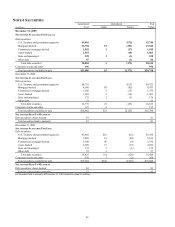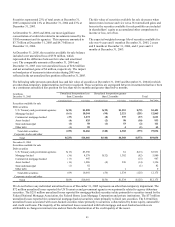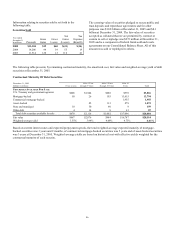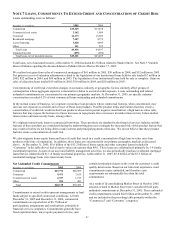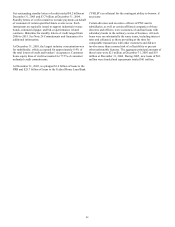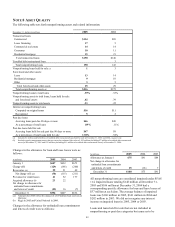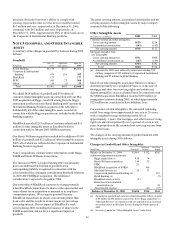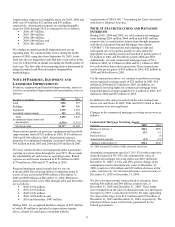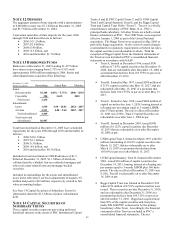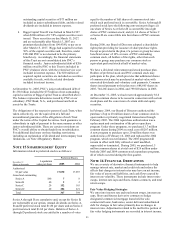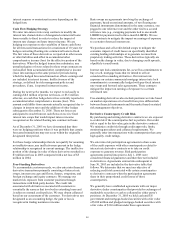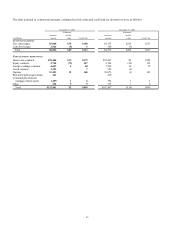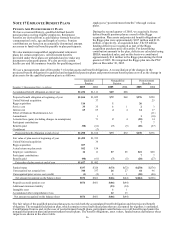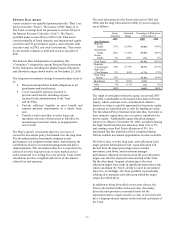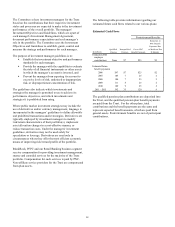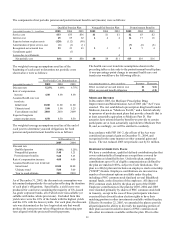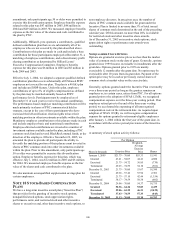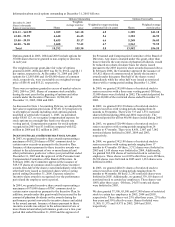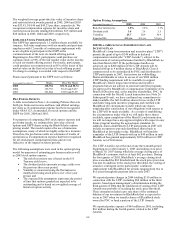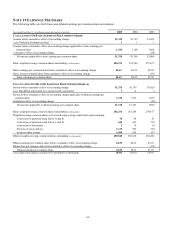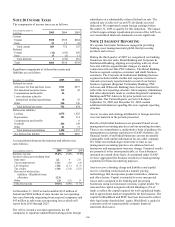PNC Bank 2005 Annual Report Download - page 94
Download and view the complete annual report
Please find page 94 of the 2005 PNC Bank annual report below. You can navigate through the pages in the report by either clicking on the pages listed below, or by using the keyword search tool below to find specific information within the annual report.94
interest expense or noninterest income depending on the
hedged item.
Cash Flow Hedging Strategy
We enter into interest rate swap contracts to modify the
interest rate characteristics of designated commercial loans
from variable to fixed in order to reduce the impact of
interest rate changes on future interest income. We are
hedging our exposure to the variability of future cash flows
for all forecasted transactions for a maximum of 10 years for
hedges converting floating-rate commercial loans to fixed.
The fair value of these derivatives is reported in other assets
or other liabilities and offset in accumulated other
comp rehensive income (loss) for the effective portion of the
derivatives. When the hedged transaction culminates, any
unrealized gains or losses related to these swap contracts are
reclassified from accumulated other comprehensive income
(loss) into earnings in the same period or periods during
which the hedged forecasted transaction affects earnings and
are included in interest income. Ineffectiveness of the
strategy, as defined by risk management policies and
procedures, if any, is reported in interest income .
During the next twelve months, we expect to reclassify to
earnings $8.6 million of pretax net losses, or $5.6 million
after-tax, on cash flow hedge derivatives currently reported in
accumulated other comprehensive income (loss). This
amount could differ from amounts actually recognized due to
changes in interest rates and the addition of other hedges
subsequent to December 31, 2005. These net losses are
anticipated to result from net cash flows on receive fixed
interest rate swaps that would impact interest income
recognized on the related floating rate commercial loans.
As of December 31, 2005 we have determined that there
were no hedging positions where it was probable that certain
forecasted transactions may not occur within the originally
designated time period.
For those hedge relationships that do not qualify for assuming
no ineffectiveness, any ineffectiveness present in the hedge
relationship is recognized in current earnings. The ineffective
portion of the change in value of these derivatives resulted in a
$3 million net loss in 2005 compared with a net loss of $5
million in 2004.
Free-Standing Derivatives
To accommodate customer needs, we also enter into financial
derivative transactions primarily consisting of interest rate
swaps, interest rate caps and floors, futures, swaptions, and
foreign exchange and equity contracts. We manage our
market risk exposure from customer positions through
transactions with third-party dealers. The credit risk
associated with derivatives executed with customers is
essentially the same as that involved in extending loans and
is subject to normal credit policies. We may obtain collateral
based on our assessment of the customer. For derivatives not
designated as an accounting hedge, the gain or loss is
recognized in trading noninterest income.
Basis swaps are agreements involving the exchange of
payments, based on notional amounts, of two floating rate
financial instruments denominated in the same currency, one
pegged to one reference rate and the other tied to a second
reference rate (e.g., swapping payments tied to one-month
LIBOR for payments tied to three-month LIBOR). We use
these contracts to mitigate the impact on earnings of exposure
to a certain referenced interest rate.
We purchase and sell credit default swaps to mitigate the
economic impact of credit losses on specifically identified
existing lending relationships or to generate revenue from
proprietary trading activities. These derivatives typically are
based on the change in value, due to changing credit spreads,
of publicly -issued bonds.
Interest rate lock commitments for, as well as commitments to
buy or sell, mortgage loans that we intend to sell are
considered free-standing derivatives. Our interest rate
exposure on certain commercial mortgage interest rate lock
commitments is economically hedged with pay-fixed interest
rate swaps and forward sales agreements. These contracts
mitigate the impact on earnings of exposure to a certain
referenced rate.
Free-standing derivatives also include positions we take based
on market expectations or to benefit from price differentials
between financial instruments and the market based on stated
risk management objectives.
Derivative Counterparty Credit Risk
By purchasing and writing derivative contracts we are exposed
to credit risk if the counterparties fail to perform. Our credit
risk is equal to the fair value gain in the derivative contract.
We minimize credit risk through credit approvals, limits,
monitoring procedures and collateral requirements. We
generally enter into transactions with counterparties that carry
high quality credit ratings.
We enter into risk participation agreements to share some
of the credit exposure with other counterparties related to
interest rate derivative contracts or to take on credit
exposure to generate revenue. Risk participation
agreements entered into prior to July 1, 2003 were
considered financial guarantees and therefore not included
in derivatives. Agreements entered into subsequent to
June 30, 2003 are included in the derivative table that
follows. We determine that we meet our objective of
reducing credit risk associated with certain counterparties
to derivative contracts when the participation agreements
share in their proportional credit losses of those
counterparties.
We generally have established agreements with our major
derivative dealer counterparties that provide for exchanges of
marketable securities or cash to collateralize either party’ s
positions. At December 31, 2005 we held cash and US
government and mortgage-backed securities with a fair value
of $100 million and pledged mortgage-backed securities with
a fair value of $163 million under these agreements.


